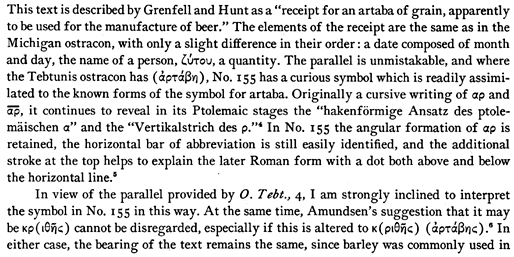
|
|||
|
|
|||
|
imperial year is not used in the beer receipts from Karanis, and the
date, consisting of the month and the day or of the day alone, takes
the initial position, as in a hitherto unpublished ostracon of the
early first century A.D.
Inv.9410
Even more pertinent than these to the problem of No. 155 is an ostracon of the second century A.D. from Kerkethoëris.3 0. Tebt., 4
|
|||
|
|||
|
|
|||
|
Created by the Digital
Documentation Center at AUB
in collaboration with Al
Mashriq of Høgskolen i
Østfold, Norway. 990208 PN - Email: hseeden@aub.edu.lb |



 receives a
similar addition in 0. Mich., 1, 90, 2.
6. Cf. abbreviations listed by Bilabel, Op. Cit., 2302. 0. Mich., 1,
169 has the angular
receives a
similar addition in 0. Mich., 1, 90, 2.
6. Cf. abbreviations listed by Bilabel, Op. Cit., 2302. 0. Mich., 1,
169 has the angular  followed by an oblique stroke for
followed by an oblique stroke for  which should replace the editor's
which should replace the editor's 